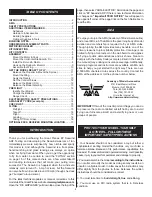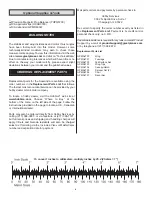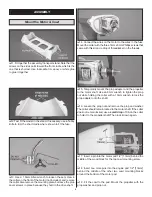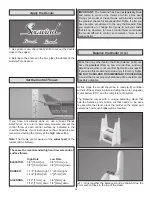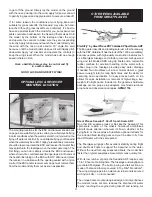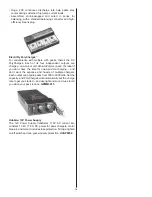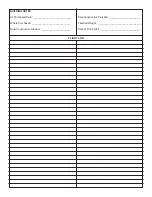
16
Always be conservative so the motor won’t quit unexpectedly
and you will have enough battery to land under power.
Takeoff
The Seawind is a joy to fl y from water, but there are a few
techniques that should be used to insure success. The most
important thing is to fl y your Seawind the fi rst few times
when the winds are relatively calm–0 to 5 mph is preferred
(especially if fl ying from water!). Later, once you have become
more experienced with your Seawind, you will be able to fl y
it on windier days.
If you’re a little nervous about fl ying from water, it may be a
good idea to make your fi rst fl ights over dry land (see the
“Taking Off From Grass” section on the next page). This
will allow you to get the model trimmed for straight-and-level
fl ight and get a good feel for how it fl ies.
When you get to the pond the fi rst thing you should do (if you
haven’t already performed the lateral balance) is to practice
taxiing the plane at different speeds. Note that holding full
“up” elevator will hold the water rudder down, thus providing
more control. Also note that if you ever need to make a
sharp “U” turn, the Seawind can just about turn around itself
when moving as slow as possible with the motor at an “idle”
rpm. But at higher speeds the ailerons may also be used to
assist in turning. If it is too windy the Seawind will usually
“weathervane” into the wind, making turns across the wind
diffi cult. In these conditions about all you can do is execute
turns at faster speeds (which will require more space), or
avoid windy conditions altogether.
Use these techniques to position the Seawind for takeoff and
to get it back to shore when you’re done. If the Seawind ever
gets into a situation where one of the wings becomes partially
submerged, immediately pull the throttle back to stop its
forward motion. Otherwise, the wing will dig deeper into the
water. This is a rare occurrence, but if it happens more than
once or twice during your taxiing tests this is probably an
indication that it is too windy to takeoff from water.
When conducting higher-speed taxi tests (up to 1/4 to 1/3
throttle), observe which, if any, wing tip drags in the water.
If, after small aileron corrections to level the wings, one wing
tip still has a tendency to “hook,” the opposite wing may need
some weight. Add weight to the “light” tip or remove some of
the weight you may have previously added to the “heavy” tip.
When ready for takeoff, the Seawind must be pointing
directly into the wind–and the stronger the wind, the
more important this will be. Once the model is pointing into
the wind, smoothly advance the throttle to full power while
simultaneously holding some “up” elevator. This will keep the
nose up, the water rudder submerged, stabilize the plane
and allow it to rise up out of the water without skipping. While
the model is building speed, if necessary, use the ailerons
to level the wings and use the rudder to make heading
corrections. Like all airplanes, the objective is for smooth
takeoffs–but when taking off from water you should also
avoid getting the model into a “skipping” mode. If the model
does get into a situation where it begins to skip off the water,
you must either abort the takeoff by pulling back the throttle
or apply full power and takeoff. Once airborne, the Seawind
shouldn’t snap or stall, so while you may want to relax the
elevator a little, you can still maintain an aggressive climb.
To summarize the takeoff procedure: point the model into the
wind, then smoothly advance the throttle using the rudder to
maintain heading. Hold some “up” elevator to keep the nose up
and get the model airborne once it has gained enough speed.
If it does get into a “skipping” mode, don’t try to smooth it out.
Instead apply full power to get the model off the water or throttle
back to abort the takeoff.
Flight
Once the model is airborne and has climbed to a comfortable
altitude, the fi rst priority will be to adjust the trims to get it fl ying
straight-and-level. Continue to fl y around, getting the model
properly trimmed while you get a good feel for how it fl ies. If the
model is fl ying too fast, simply remember to throttle back. While
still at altitude, cut the power to see how it handles in a gliding
situation to simulate a landing. Switch between the high and low
rates to see how the model reacts. Remember to monitor your
fl ight time so the motor doesn’t unexpectedly cut off.
Landing
Landings with the Seawind can be a thing of beauty. She is
“slippery” and tends to glide long, so set your approach a little
farther out than you might normally expect–if you end up short
you can always throttle up. If the winds are calm (5 mph or less)
you can throttle all the way back cutting power completely while
still on the down wind leg just before you make your cross-wind
turn. Maintain airspeed and establish a descent by keeping
the nose down. When the model has reached an altitude of
approximately 10' [3 meters], gradually slow its speed by leveling
the nose. The lower and slower it gets the more elevator you
should apply until it is just a few inches off the water. At this time
apply full or nearly full elevator to execute a landing fl air as the
Seawind touches down. The most important thing about landing
on water–whether you are coming in a little “hot” or too slow–is
to get the model to fl air, keeping the nose up out of the water.
Taking Off From Grass
Surprisingly, the Seawind can easily takeoff from grass (your
fl ying buddies will be tickled when they see you taking off
and landing a fl oat plane in the grass!). In our testing, we’ve
found that shorter, dry grass provides the least resistance,
so if taking off from tall grass more space will be required. In
ideal conditions the Seawind took only about 50' [15 meters]

